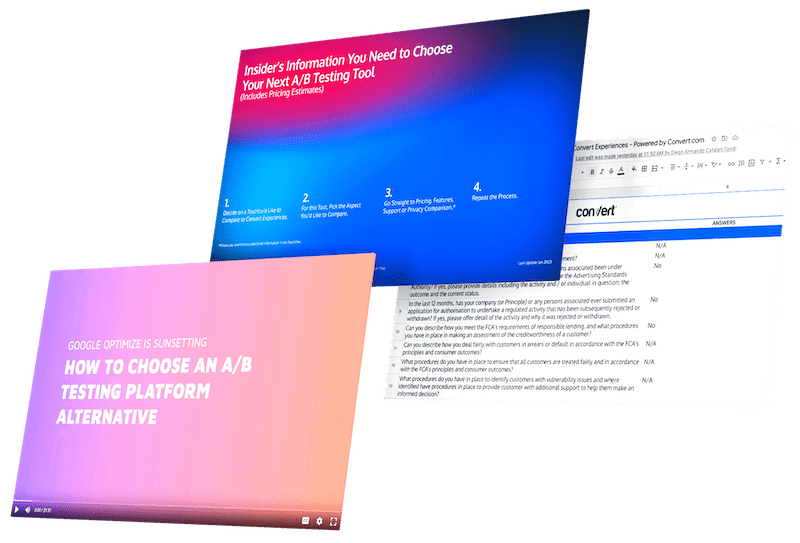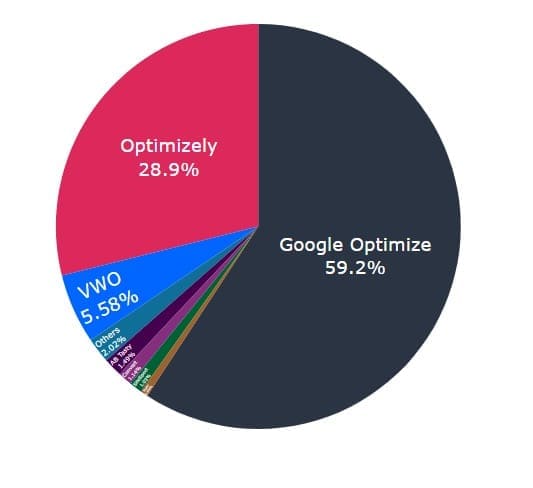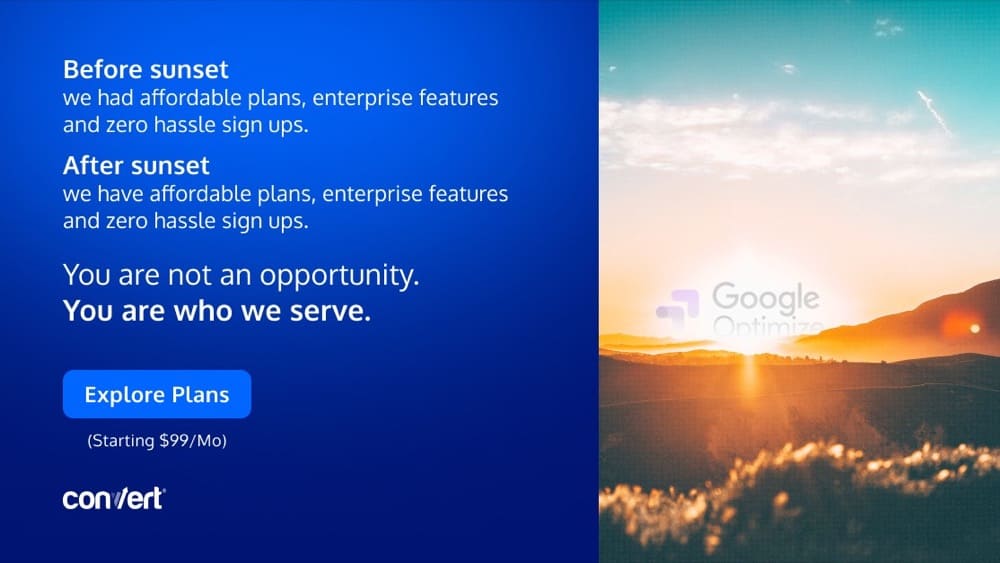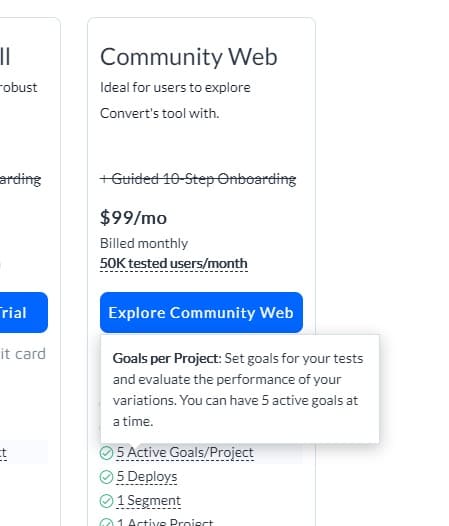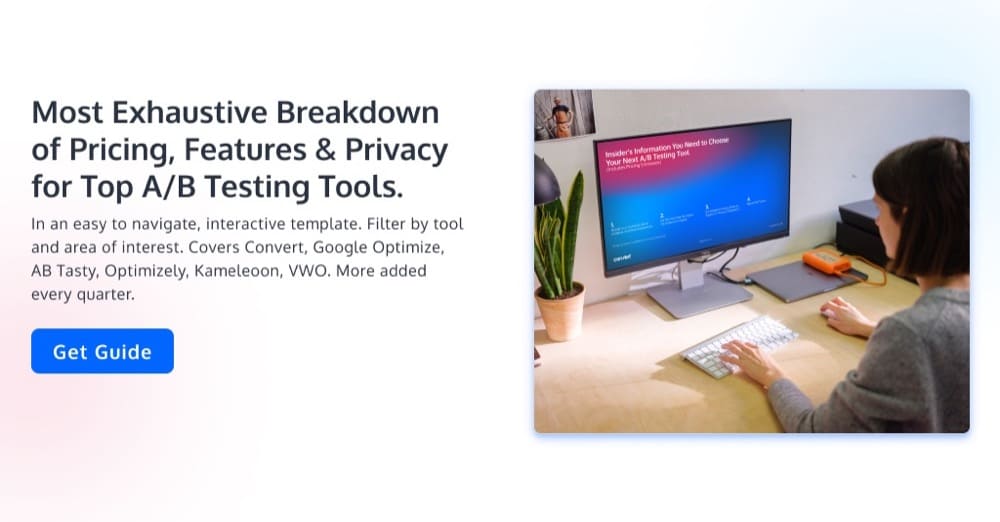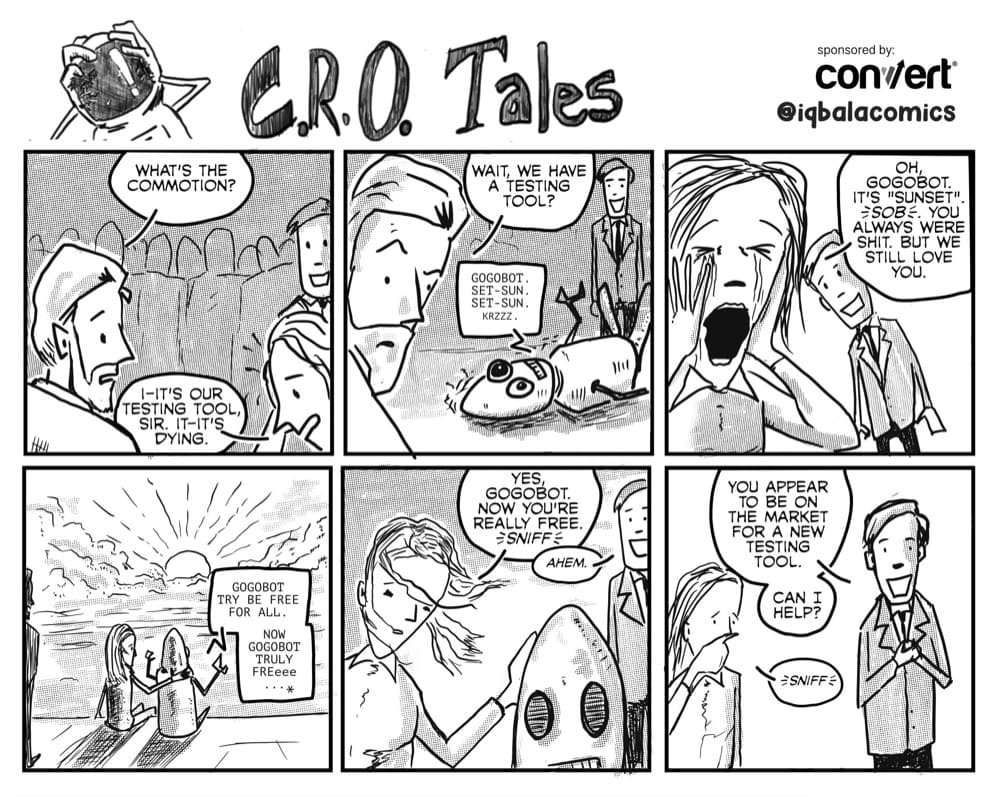Google Optimize Sunset: 15 Seasoned Testers Reveal Their Exact Blueprint to Pivot & Move Forward

- Convert announces its official GA4 integration as a Google trusted partner. Read More.
- Import your Google Optimize experiments, data, and settings in 27 seconds. Explore our data migration tool.
Great content isn’t created by an individual. Say “hello” to the experts who’ve made this guide possible. Over 80 years of experimentation and A/B testing experience.
What started as only whispers on the streets of CRO LinkedIn finally materialized into a nightmare for Google Optimize fans…
Google Optimize and Optimize 360 will no longer be available after September 30, 2023.
It’ll go the way of Google Stadia, Hangouts, and Google+. Another year, another Google product killed.
Before the official sunset announcement from Google, the rumor mills had been churning for quite some time. The whispers only intensified when Collin Cromwell of Kameleoon posted a question on LinkedIn.
Then, our CEO, Dennis van der Heijden, dug into it and we saw moves indicating the rumors had feet to stand on.
- Google teaming up with Optimizely, to bring ML- and AI-driven customer experience innovations to the market, seemingly to take on Adobe Experience Cloud and Salesforce Commerce Cloud
- Google deprecating the Google Optimize certifications as criteria to earn premier partner statuses (and hints that Firebase A/B testing tool would be the first to go)
- Test runtimes on GO reduced from 90 days (which wasn’t much for low-traffic sites to begin with) to 35 days — which, together with everything else happening, seemed like they were pushing some users out.
Certified Google Optimize experts knew of the sunset since March 2022. But they were asked to bite their tongues… because of NDAs.
But here’s the thing.
Google Optimize is being retired because the landscape has changed. Even the priorities of the parent company have also changed. So, these shifts are normal; it’s not a moral dilemma.
The furor is due to the fact that Google Optimize had such a massive “purported” market share.
“Purported” because when we dig deeper and
- De-duplicate entities (consolidate several domains and subdomains into their parent business entities) and
- Discount the websites that never tested actively with Google Optimize
We are left with only 5,000 domains (or businesses) that are likely to consider Google Optimize alternatives.
This is Convert’s data and we’ll make more granular segments and distinctions available soon for all the A/B testing tools in the market via our Market Share App.
This means although there many small to enterprise level businesses using Google Optimize, the uproar that makes it seem the sunset spells ruin for the CRO space is baseless.
There’s a way out for these businesses. In fact, there has always been a way out.
If you’re reading this, you’re probably one of the 5,000 affected GO users feeling lost, wondering what’s next for you. Where will your historical test data go? How do you migrate from Google Optimize to another A/B testing tool? Which conversion rate optimization platform is the right fit?
Right now, you’re being bombarded with “come to us” messages from Google Optimize competitors. You feel like a stranded penguin on a broken ice sheet. If you make the jump, you don’t want to land into more problems… or the wrong fit.
We, along with 15 seasoned CRO experts, have got you covered. Right now, you’re reading the exact blueprint you need for a smooth Google Optimize migration.
These experts know where it bites, having worked in the optimization industry for decades. In this article, they’ll tell you everything you need to know to make the switch from Google Optimize to your next soon-to-be-favorite A/B testing tool.
But first, why should you trust this among other Google Optimize sunset migration pieces out there?
When the Google Optimize Sunset News Hit, Convert Was Just Being Convert
Our CEO, Dennis was one of the first people to announce the sunset, publicly:
As the reality started to sink in, a slew of experts and vendors put out “Google Optimize Alternative” posts.
That’s a perfectly natural reaction to hearing your big fish competitor is signing off the block. You’d be excited to swoop down like a hawk and pick up stranded users looking for a new tool.
But if that isn’t a bit opportunistic, what is?
Listen. There’s nothing wrong with that from a business point of view. But if you’re looking for a vendor you can trust, an A/B testing platform that actually cared for your needs from day one, you’ll need to do a little bit of digging. There’s evidence to prove who was there for you before your ice sheet broke off and got you stranded in the middle of the ocean.
FUN FACT: Convert’s “Google Optimize alternatives” post has been around for more than a year. We have never gated pricing.
Run this experiment → Do it because it is important to understand which vendors have a legacy of supporting all Google Optimize switchers (and not just the lucrative large accounts).
● Use the WayBack Machine.
● Review the pricing pages of all the alternatives on your list.
● Note the ones who had clear, transparent, public pricing before January 20th!
Yup… you are not just an opportunity for us. You are who we’ve served… always.
It’s Important to Bust a Myth At This Stage: Be Wary!
It’s come to our attention that social media is flooding with claims from vendors that Google has announced their preferred replacements for Google Optimize.
This is NOT the case.
Google has teamed up with A/B testing vendors who also are its cloud partners (so these vendors use Google hosting, instead of Amazon Web Services or any other option) to work on the GA4 API that will allow data to travel to and from Google Analytics to your chosen A/B testing platform.
Take a look at the current version of the announcement yourself:
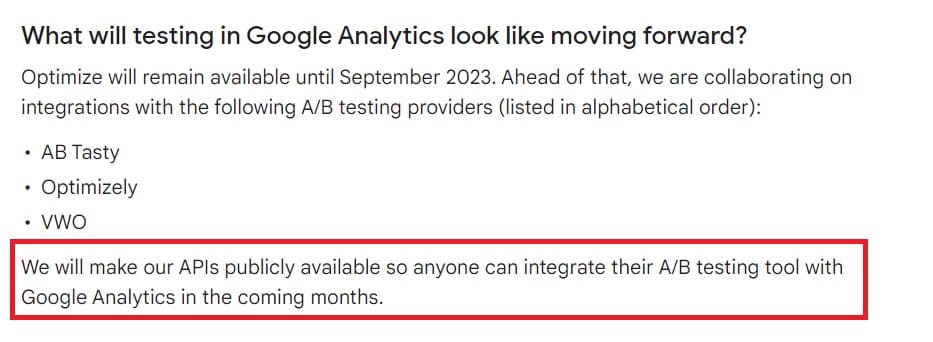
There is no mention of a preferred replacement. It is abundantly clear that ANYONE can connect to the API, once it is publicly available. And that’s exactly what we at Convert have done.
You can explore our official GA4 integration here.
So be wary of misinformation on social platforms. It might be a ploy to obscure the truth amidst the panic.
That’s why your Google Optimize migration journey has to be extra careful. Some A/B testing vendors are using dark patterns to snatch up new users left in the cold by Google Optimize’s sunset.
These dark patterns are persuasive tricks to get you to sign up, even though they’re not usually in your best interest. For example, lack of clarity on the pricing page — some features are kept vague with zero explanation about the full extent of how you can use them in that plan.
This gets you in but sets you up for a surprise when you find your experimentation limited by what your plan affords you.
You’ll spot this when questions pop up in your mind while reviewing the pricing packages for these A/B testing tools. If they do, don’t dismiss them.
Find out if they’re answered on the page, maybe in the FAQ section. If there aren’t answers to your questions, contact sales (if you’re okay with that).
If not, go to a tool that gives you 100% clarity about what you’re getting. Check out Convert’s pricing packages (you can hover over the features to get the full picture). No surprises.
Deborah O’Malley, Founder of GuessTheTest, discusses this in her “Google Optimize is Sunsetting: How to Choose an A/B Testing Platform Alternative” video.
Here are some key takeaways from the video:
- Shifting from Google Optimize to a new A/B testing tool, you want to look out for features such as:
- Ability to run multiple tests at once (A/B/n testing, split URL testing, multivariate testing)
- Visual editor and code editing (HTML/CSS/JS)
- Unlimited tests/variants
- Speed and anti-flicker
- SRM checker
- Stats engine, analytics, and reporting
- Segmentation and targeting, and more
- Find out how the tools you’re considering handle first and third party cookies. Also, what are they doing to mitigate the fact that cookies will be obsolete in the near future?
- Before you get locked into a new tool after migration from Google Optimize, check out the support features. Do you get onboarding training? What about transition support specifically for GO switchers? What comes with basic customer support? Other add-ons, etc.
- Choosing a new A/B testing platform based on your individual needs is the best way to migrate from GO. But a good starting point is checking out the comparison on Convert’s VWO alternative page. “It is factual information presented in a very clear way.”
15 Veteran Testers Give Their Take on the Sunset and Suggest Your Next Steps
Let’s admit it! GogoBot broke our hearts.
But it is time to wipe away the tears, and move on with a solid plan of action.
We asked 15 of the most vocal testers in the Google Optimize sunset aftermath what they thought the experimentation space would look like post the demise of Google Optimize, and more importantly, what can the affected who need a replacement do.
Here’s what they told us:

But those are just snippets. The juicy part is where they tell you what you can do to move forward in this 9-part Google Optimize migration blueprint.
Should You A/B Test At All?
But wait, why shed tears for the demise of Google Optimize? Should you even bother A/B testing in the first place? What if this is an opportunity to pack it in?
We already know that A/B testing is great in the way it reveals opportunities to improve your user experience and generate more revenue from available traffic but is it right for you right now?
I think that Optimize’s sunset will ultimately benefit the CRO space. Though it’s important to recognize that it was a great entry tool for many of us to get familiar with A/B testing, it’s no secret that it can be easily misleading due to the way it presents the data, potentially making businesses of all sizes make the wrong decisions and miss out on the real value of experimenting.
My recommendation to those impacted by this sunset is to take this as an opportunity to learn and rethink their overall testing strategy.
It won’t only allow them to pick the right tool to migrate to, but could also make them realize that either A/B testing might not be a good fit at the moment, or that they’re leaving money on the table by not doing it more actively.
Carlos Trujillo, Experimentation Strategist at Speero
Here are two assets that’ll help you understand in broad strokes whether you should be A/B testing or not:
- Convert’s A/B Testing Significance Calculator: This nifty tool tells you how much traffic you need to see statistically significant results, and for what kind of lifts (micro or macro).
- You can also leverage this A/B testing value calculator to quantify the impact of testing on your online store. Attribute $$$ to the effort.
Budget Strapped? How About A La Carte Service?
Maybe you don’t need to pay for the whole A/B testing package, especially if your budget doesn’t allow it and there isn’t a long-term optimization strategy to justify it.
You can just take what you need when you need it. But where would you find such an option?
First, I would approach this as a great opportunity to improve in an area that brands should be turning to more, particularly in these economically challenging times. Making small investments to have certainty on what the big levers are to success is a smart move, in the end.
There are two parts to focus on with this transition – tool options and testing program and process. From a tool perspective, there are great and very affordable tools available that can take a testing regimen to new heights without much work or additional funding. Convert is a great example that comes to mind.
As one moves into a paid platform from a free one, it’s important to establish a testing program, process and overall operation that helps organizations get the most out of the tool investment. If needed, getting some limited, outside support to help you build a strong test & learn program is recommended.
At LiftCentro we offer coaching to help internal teams build out internal processes that leverage in-house resources to do the execution. Similarly, CRO agencies that are well versed with the testing platforms can help augment internal teams to maintain a good testing velocity over time.
Last, but not least, we see offerings like our Test a la carte program as a sensible way to start to experience testing with a new tool, without having to actually pay for the tool. One of the benefits that a free tool does offer is the ability to test spontaneously when specific questions come up without having to think about long-term license agreements.
We see this as a sensible transition phase into more robust testing platforms while still keeping costs down.
Jake Sapirstein, Founder, Head of Strategy at LiftCentro
While no one can deny that the value of experimentation is in running tests consistently, for brands that want to build up to getting that buy-in for a paid tool, an outsourced a la carte option is a potential interim solution.
Time Is of the Essence
The success of your Google Optimize migration really hinges on preparation and proper timing. You need a clear-cut plan to manage a smooth transition, without your experimentation program missing a beat.
Here’s how one of our CRO experts suggests you go about it:
A transition plan is just as important for small to medium businesses as it is for enterprise, to ensure a smooth move from GO, without having to sacrifice this important part of CRO testing.
1. Start evaluating platforms early (start now): Create a checklist of what is important for your organization in regards to testing solutions. Take advantage of platform demos. Speak with a CRO expert to help you with the process.
2. Plan out costs inclusive of: New platform costs, integration costs, implementation costs, ongoing support. Will you need to show the value of CRO to your senior stakeholders to ensure budget can be allocated?
3. Plan a timeline from now until 30 Sept 2023: Ensure any tests you have running have a clear plan to end at least one month before 30 Sept 2023. Have a cut-off date for any new tests to start running.
4. Consider your onboarding plan for your new platform: Who in your organization will own the new platform? Will you have ongoing support with your new COP? Ensure you have accounted for training sessions before and after you go live.
Loredana Principessa, Founder of MAR-CO
To be fair, Google has given ample room for GO users to make a smooth switch regardless of size. Make the most of the allowance and start taking action today. Don’t wait to scramble hastily when the countdown timer turns red.
With Google Optimize sunsetting we’re not only losing the platform that most companies got started on – and oftentimes stuck to – for their on-site testing.
We’re also losing the strongest branded platform known to a broad audience. Google Optimize was to many companies a badge of approval for on-site testing as a practice.
I’m sure we can all agree on the platform’s lacking capabilities, but in many cases, it could provide exactly what many companies needed. Easy activation of testing with direct integration to GA. The core challenge we face now as CRO practitioners is not much different than what it was before this news, however.
We continue to be ambitious on our clients’ behalf, and look to move them towards more sophisticated tools with advanced targeting and testing opportunities. And many established testing tools are giving companies an easy way in to trial their platforms. I’d urge current Google Optimize users to make the most of this because the big difference now is that they can’t simply consider alternatives to Google Optimize. Now that it’s out of the picture they need to take action.
Nicolai Høg, Director of Addressable Content (CRO, DCO and UX) at GroupM Danmark
In our chats with several agency partners, we’ve come across the idea that some GO users are comfortable waiting till the actual sunset. Or so they believe.
Our partners think that these folks will require a second trigger. Namely, the sunset of Universal Analytics (which happens 1st July 2023) to realize that they now must integrate a dying A/B testing platform with GA4.
It is then that revamping a large chunk of their experimentation tech stack in one go will start to seem more appealing.
Don’t forget to account for the time it’ll take to research alternatives, dig into RFIs, and secure the budget for your preferred tool. The more long drawn out this process gets, the more buffer time you need from the GO sunset date of 30th September to get your testing house in order.
I think the biggest thing about the loss of Google Optimize is the impact it will have on brands that are just getting started on their optimization journeys. It can already be a hard sell to convince stakeholders to invest in optimizing UX instead of pumping more budget into paid ads.
By removing an option that was free at the point of entry, allowing brands to trial CRO and see the tangible benefits, it’s going to become even more difficult to convince decision-makers to make that investment.
I know there has been a lot of conversation about the integration of A/B testing in GA4, but I think we all agree that Google is unlikely to include a real-time WYSIWYG editor within GA4, so the ultimate outcome is more likely to be reporting-based, which doesn’t solve the entry-level issue.
Joe Marshall, UX Research & Conversion Manager at Clicky Media
Buckle up, because this next section is jam-packed with vital information☟
Plan for the Long Haul. If You Continue Testing, COMMIT
One of the best parts of Google Optimize is that it allowed everyone to get their feet wet. It was like the optimization watering hole for beginners, enthusiasts, curious minds, and people just glancing through.
If you’re going to start paying for an A/B testing tool now, it has to count. The same attitude that made GO ‘just okay’ wouldn’t cut it when you need to prove the ROI of testing to stakeholders.
You need a long term strategy for experimentation. That’s just how it’s going to work.
If I was a business leader of a firm using Google Optimize, I’d definitely have a dual track approach:
1. Migrate existing data of running experiments onto a capable A/B testing tool and this process should have started soon after the official announcement.
2. Set the house in order and deploy experimentation strategically with the resources and the team it needs to exceed stakeholder expectations.
Some additional thoughts here as I rarely see that being taken up:
It is paramount for the key stakeholders to decide NOW if a free tier is even beneficial in the long term. Experimentation is not a one and done process. You can start here at this pricing tier but don’t be rooted to it.
Come to think of it, your empirical research program that involves A/B testing is a strategic exercise that can influence the brand itself because you’re learning from your true population with long drawn cohorts of validated data against one’s assumptions and hypotheses and that’s creating a new UX that the customers want.
It’s right up there as the single most important work that an organization can do to not only survive but thrive under the current macroeconomic conditions. Plus you get to see how much of a punch each dollar spent packs in experimentation versus investing into the abyss of a brand exercise without getting any meaningful data.
Therefore, the companies have to build a strong foundation when it comes to A/B testing with experimentation processes, also, build a great team around it, be it in a centralized, decentralized or a hybrid model of a team structure.
Sumantha Shankaranarayana, Founder and Chief Optimizer at EndlessROI.com
The CRO space is going to be filled with “far more intentional” experimentation because that’s going to be the only way to thrive when the ubiquitous free tool is out of the picture.
To date, it has been easy for some individuals and/or teams to install Google Optimize and feel productive, despite a lack of rigor around experimentation. With the sunsetting of Google Optimize, I predict that experimentation will become far more intentional.
Moving forward, this sunset will shift teams to think more strategically about experimentation. With the announcements around Google Optimize’s sunset paired with the need for overall efficiency at the forefront for companies, there is increasing awareness around the value of experimentation and companies that were not previously experimenting are now exploring how to do so. We are supporting any existing clients who were on Google Optimize in a smooth transition to alternative technology solutions.
Sophie Buonassisi, Vice President, Optimization at Spiralyze
And if you’re still wondering, “Where can I get a free A/B testing tool like Google Optimize?” maybe because you’re not ‘doing much’ in experimentation and just want something to support a low-effort approach, just know that you will find it.
But you’ll get what you pay for — and that doesn’t usually translate to tangible benefits for your business.
We know that there are no free lunches, but some still think you can get an A/B test for free. As Google Optimize is sunsetting, many are now looking for the next free tool, and tool providers are jumping on the bandwagon offering their revised “free” or entry-level plans. But is this really the way to go?
Running a successful experimentation program requires so much more than just a testing tool. You need a proper data setup, you need qualitative research, a planning & reporting structure, processes, organization and much more. In this scheme of things, the cost of the A/B-testing tool is a small sliver.
Our experience is that companies only willing to commit zero dollars to the tool are often not “fit for experimentation”. So, when Google Optimize goes, it will be a watershed moment for the industry. Some organizations will rise up to the occasion, start taking experimentation seriously. Some will fizzle out to the sound of – “it never worked”, “it is not for us”, “A/B testing is a hype”. Who will be the winners, only time can tell.
John Ekman, Founder & Andreas Gref, Head of Experimentation at Conversionista
Here’s the thing… you don’t want to find yourself in a similar situation again. So opt for tools that have a long standing legacy in the A/B testing space. One that won’t disappear overnight again.
You should think about:
- How much will it cost to scale up testing (are you looking to spend upwards of $30,000 on your experimentation platform?)
- Will you get access to the gold standards of tomorrow — server-side and full stack testing at affordable prices?
- Will you get support? Proactive and fast, especially when you code complex experiments (which we hope you will ‘cause that’s the whole point of having an optimization program — to mature!)
- Do you have everything you need to really double down on the two phases of experimentation holding teams back: ideation and prioritization?
Convert has written over a dozen high quality articles with 100+ of the best minds in experimentation. We’ve covered everything from prioritization to innovation to communication, metrics, meta analysis and learning documentation
Integrations Are an Important Consideration
And not just naughty rumors around supposed “preferred” replacements. 🙂
Integrations with GA4 aren’t rocket science. Each and every A/B testing vendor—if they want to—can offer seamless data back and forth with Google Analytics 4. Plus with Google’s advanced API which will be publicly available, we don’t believe integrating with GA4 will be an issue.
A more pertinent question is: Will your alternative platform play nice with the rest of your stack? Or will they charge you extra for premium integrations?
For example, Convert’s entire library of 90+ integrations (and no, we don’t count one integration with Zapier which then connects to a bazillion platforms) is accessible to ALL customers—even those who signed up with us 13 years ago—and are still around paying their original price!
Unpopular opinion here, I loved Google Optimize. I think it was a fantastic way for businesses to dip their toes into experimentation due to its generous free tier. It integrated well with GA and there was enough there to get started with. Was it the best tool on the market? Absolutely not.
I do think it got more people in the experimentation game though which is surely a net positive. Now it is being sunset we’ll definitely see market share increase for the other platforms on the block. The ones to capture this particular segment will integrate well with web analytics tools and offer a generous free tier to help companies test the waters.
Scott McMullan, Analytics & Experimentation Director at Bedrock42
Don’t Gloss Over Privacy. This Will Be Your #1 Concern in the Years to Come
We’re already in the ‘future’ where privacy is a serious concern for most people. Online experimentation lives on the fringes of internet privacy—where the discourse and regulation are hottest.
Most regulations—GDPR and CCPA—affect how effectively A/B testing tools can perform tests and present accurate results. But the most interesting part is… that’s not the end.
There’s a cookieless future coming.
Consider how much effort it’ll take you to migrate off Google Optimize, do you want to do that again in the next 1 to 2 years? All right then. Your migration has to be future-proof.
The sunset of Google Optimize serves as a reminder for advertisers that the landscape of A/B testing is changing. This change is driven by the increasing implementation of General Data Protection Regulation (GDPR), which has a significant impact on how A/B tests are conducted.
Under GDPR, A/B tests can only be carried out with the explicit consent of users. This means that users must be presented with a landing page where they must accept cookies before the A/B test can be run.
While A/B testing tools aim to provide a seamless user experience, this is no longer possible with GDPR in place. Allowing users to see a landing page before accepting cookies could impact the results, while blurring the background may have a negative impact on user experience Advertisers must therefore consider alternative methods to conduct A/B testing.
One such option is server-side testing, which is conducted on the server rather than on the client side (the user’s device). This eliminates the need for user data to be stored or processed on the client side, reducing the risk of data breaches or unauthorized access to sensitive information, which is a key concern under GDPR. However, this method requires a higher degree of technical expertise and control over server infrastructure.
Nadav Druker, Leading Paid Advertising at Apomedical
Totally tooting our own horn here.
But Convert has been at the forefront of the privacy discussion since 2018.
- You can explore our privacy policies and roadmap.
- Plus, you can also educate yourself about the plethora of privacy laws that’ve been passed, and how Convert complies: Explore Privacy Hub
An Agency? You Need Features Built to Support Your Business Model
For agencies, your next A/B tool after Google Optimize needs to have features that support your business and relationship with clients.
For example, reporting and data visualization features are particularly important to facilitate the easy sharing and communication of results with clients.
You may also like full customization and personalization, where you can set different goals, and segment visitors based on various criteria such as behavior, geolocation, device type, and control traffic distribution.
Simon Clark, who’s very optimistic about the GO sunset news, goes for powerful testing tools. And this is what he means by “powerful”:
Before this (sunset) news, we had already begun to create timelines for GA4 rollouts and what this meant for our A/B testing dashboards, so we were already deliberating what changes would need to be made. This news has given us some clarity on the situation and a kick up the butt to figure out our A/B testing and reporting requirements.
On my checklist is a powerful testing tool, where we can quickly create experiments with CSS & JS, target the right pages & people and importantly, one where we have full trust in the reporting functionality (which we definitely did not with GO). Cost is undoubtedly a factor to an agency too so must be considered, especially when switching from a free solution. All in all, I am positive about the future of our experimentation programmes and I’m excited to learn new tools, speak to new people and make improvements overall, which we may not have done. Sunsets are beautiful.
Simon Clark, Head of CRO & UX at Evolved Search
If you felt that kick up the 🍑 too, and want to check out more powerful A/B testing tools that support your business needs, here’s a fantastic start:
Seek and You Shall Find – Help!
If you’re a Google Optimizer, don’t stress, sweat, or fret over the sunset. Here’s a guide to ensure a silky smooth migration to greener pastures:
Make Maslow proud: Take stock of your current A/B testing, multivariate and optimisation needs. Which features do you love? Which functions do you loathe? What are you ultimately looking for in your new platform partner?
Swipe right: See this as a great opportunity to play the field and see what’s out there. As they say, variety is the spice of life! Convert.com lets you run tests for 50K visitors per month from just €1000 a year.
The great migration: Once you have selected a new solution, create a plan for the migration, including data transfer, training, and process changes. Consider any custom scripts, integrations, or code snippets you are currently using and how they will be impacted by the migration.
Back in the lab: Before fully switching, test it! Ensure it works as expected and that your data has been transferred correctly.
Pick me coach: Provide training and support to your team to ensure they are comfortable with the new platform and can effectively use it to support your optimisation efforts.
Migration monitoring: Once the great migration is over, monitor your results. Use this data to refine your strategy and processes going forward. Follow this blueprint, minimize the impact of the sunsetting of Google Optimize, and continue to deliver sensational digital experiences to your users.
Miles Hoogwerf, CRO Consultant at DEPT®
There are lots of smart consultants in the space. Pick someone who has worked with every platform on your list, and will be able to unbiasedly point you in the right direction.
Start by checking out the A/B testing experts and CRO experts we’ve suggested you follow on LinkedIn.
Avoid “tool partners”. They can cut down your learning curve once you’re already chosen a vendor. Instead, take the unbiased advice of an individual who isn’t monetarily motivated as opposed to falling into pre-selection bias.
Just ‘Cause We Love Refreshing Takes!
Here is our favorite contrarian optimizer, Lukas Petrauskas, with his spicy post-GO thoughts
🌶️🌶️🌶️
1. Google Optimize going away means nothing. Because most companies don’t know what Google Optimize is. But those that did use it, will just start paying for an A/B testing tool or, less likely, build a simplified tool internally. Those that won’t do anything about it, either were not successful in their conversion optimization efforts and will stop running A/B tests to their own detriment, or make website changes without running “formal” A/B tests — like most companies do anyway (to their own detriment).
Technicalities aside, smaller companies might get more concerned about experimentation programs’ monetary value — which is a good thing. “If we do hire you and pay your retainer fee + tool fee, what ROI can we expect?” Some agencies and experimentation influencers spread propaganda that A/B testing learnings matter more than winners that increase revenue or profitability. But it’s just their way to justify poor results and keep clients on retainer fees for longer. “Yes, we didn’t generate you any additional money, but here are some “important” learnings!” Just figure out a way to have more business-growing winners!!!!!!!!! Instead of exploiting the framing bias to phrase every A/B test as a winner only because you learned something.
P.S.: Not saying A/B testing learnings aren’t important.
2. Different logo with different pricing: This is how most companies should think about A/B testing tools. Schedule a few demo calls, ask some questions about unique experimentation needs if you have any, and choose whatever popular A/B testing tool that fits your budget. Most likely, all you need is just a feature that evenly splits your traffic. Start simple.
Expect to Sit Through a Ton of Demos & Trials
Ever come across a task that is urgent but can’t be rushed? The path ahead is somewhat similar.
It is urgent… There is a deadline… time is of the essence… Yet, you must be mindful of the unique requirements and considerations that define your business, its growth goals, and thus your experimentation program.
If you’re impacted by the sunset, my first piece of advice would be to talk to others who use different tools, and I would do this before taking out free trials. Learn from those who have used the alternatives you are considering for an extended period & you’ll get a better understanding of the tool’s capabilities & shortcomings. Sometimes you don’t realize that you need a certain piece of functionality until you do! Plus something that might only seem a minor irritation in the short term could be a major frustration over that longer-term commitment.
Matt Scyasbrook, Director of Optimisation at WeTeachCRO
So, take a step further than consuming content about Google Optimize alternatives and do your own original research. As Matt so clearly stated, the most productive way to do that is to talk to people who actually use those alternatives.
You can find them in your network.
Another way to go about this is by checking out reviews on Capterra, G2, or TrustRadius. Spot one or two comments that are particularly in-depth and show that the reviewer has actual hands-on experience with the product.
See if you can find them on Twitter or LinkedIn. Start a conversation and ask questions unique to your use case. Chances are they can help give you an unbiased opinion of the A/B testing tool and help you decide if a free trial (if available) or demo is worth it.
You can also find more people to talk to by engaging with content with the LinkedIn hashtag “#googleoptimize”. Go to the comments. See suggested alternatives (note: You’ll find vendors promoting their products, filter those out). Chat with the people who suggested those alternatives and get first-hand feedback.
This can significantly cut the time you spend going through demos and trials. But prepare to do a lot of research work so that you don’t find yourself stranded on another ice sheet.
How to Choose a Google Optimize Alternative?
In this GO migration article, we’ve learned how to choose a Google Optimize alternative from 15 seasoned CRO experts. The 9-part process goes this way:
● First, rethink your testing strategy and assess whether A/B testing is right for you.
● If you’re budget-strapped, consider A La Carte services to experience testing with a new tool.
● Prepare a transition plan to take full advantage of the time you have before Google Optimize goes away for good.
● Ensure you have a long term strategy for experimentation if you’re going to start paying for an A/B testing tool.
● In your consideration of A/B testing tools, pay close attention to integrations.
● Find a tool that’s poised to thrive through a future of increased internet privacy regulations.
● If you’re an agency, your next A/B testing tool should have features that support your business and relationship with clients.
● Ask experts and professionals in the CRO field for unbiased recommendations.
● Prepare to experience a lot of Google Optimize alternatives through free trials and demos.
As the great exodus from Google Optimize continues, those that will thrive post-sunset will be those that have implemented more than a couple of these expert-recommended migration blueprint tactics. Be one of them.
